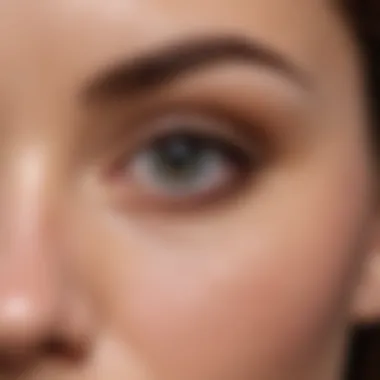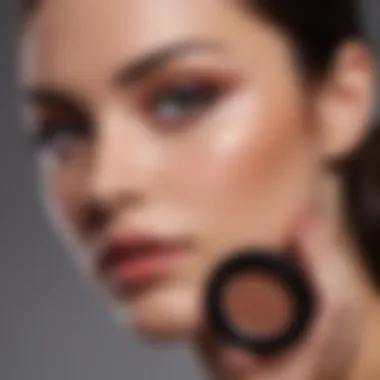Expert Makeup Techniques to Conceal Dark Circles


Intro
Dark circles under the eyes can significantly detract from a person's appearance. They may stem from various causes such as fatigue, genetics, or even stress. This comprehensive guide aims to provide effective makeup techniques that can conceal these under-eye shadows. It will delve into the importance of selecting the right products, understanding different skin types, and mastering application methods. By integrating these tips, readers will be better equipped to achieve a refreshed look that enhances both beauty and confidence.
Tips and How-Tos
Skincare Routines for Different Skin Types
Before diving into makeup application, it's crucial to establish a skincare routine that caters to your specific skin type. This foundation will not only prepare your skin but also enhance the effectiveness of makeup products.
- Dry Skin: Use hydrating eye creams with ingredients like hyaluronic acid or glycerin. This keeps the under-eye area moisturized, creating a smoother surface for makeup.
- Oily Skin: Opt for lightweight, oil-free moisturizers. Gel-based products can help control excess shine while keeping the skin hydrated.
- Combination Skin: Focus on balancing hydration. Use a light cream that suits both the dry and oily areas of your face.
- Sensitive Skin: Choose fragrance-free products. Ingredients like chamomile or aloe vera can soothe irritation.
Establishing a solid skincare routine is essential, as healthy skin acts as the canvas for your makeup.
Application Techniques for Concealing Dark Circles
Utilizing effective application techniques can be the difference between a flawless finish and an unnatural look. Here are key steps to follow:
- Prime the Area: Begin by applying a good primer to the under-eye area. This helps the concealer adhere better and reduces the appearance of fine lines.
- Choose the Right Concealer: Select a concealer that is one shade lighter than your foundation. Creamy formulas work well as they offer decent coverage without being too heavy.
- Apply in a Triangular Shape: Rather than dabbing concealer directly on dark circles, apply it in a triangular shape extending from the inner corner of the eye towards the cheek. This technique not only conceals but also brightens the area.
- Use Your Ring Finger: Gently tap the concealer with your ring finger. This finger applies the least pressure and can help avoid tugging at the delicate skin.
- Set with Powder: To ensure longevity and prevent creasing, lightly dust a translucent powder under your eyes but avoid excess, as it may enhance fine lines.
Tip: Always carry a small amount of concealer for touch-ups throughout the day, especially if you are prone to dark circles.
Choosing the Right Makeup Products
The importance of selecting the right products cannot be overstated. Consider these types of products:
- Correctors: Use peach or orange corrector shades for bluish dark circles. These can neutralize the under-eye darkness.
- Hydrating Concealers: Formulas with moisturizing agents help to combat dryness and create a natural finish.
- Setting Sprays: Incorporating a setting spray can enhance the durability of your makeup, particularly in humid conditions.
Sustainable Practices
Eco-Friendly Makeup Brands
As consumers become more conscious of sustainability, it’s vital to recognize eco-friendly brands. Look for companies like Fenty Beauty and RMS Beauty, which prioritize natural ingredients and responsible sourcing.
Tips for Sustainable Grooming
To further embrace sustainability, consider using multi-use products. For example, a tinted moisturizer can serve as both a foundation and moisturizer. Additionally, opting for refillable products can reduce waste over time.
Celebrating Diversity in Beauty
Inclusive Beauty Brands
Diversity in beauty should resonate with all individuals. Brands like e.l.f. and MAC offer extensive shade ranges and inclusive marketing campaigns, catering to various skin tones.
Cultural Influences on Fashion
Understanding cultural influences can enhance one’s makeup routine. Different cultures have unique methods and products that can inspire fresh techniques and applications.
Epilogue
Concealing dark circles involves more than just slapping on concealer; it requires a strategic approach to skincare and makeup application. By following these nuanced tips and techniques, individuals can achieve a polished and empowered look. This guide serves as a catalyst for exploring options and embracing beauty in all its forms.
Understanding Dark Circles
Dark circles, often seen as a sign of fatigue or aging, can be distressing for many individuals. Understanding these dark shadows is fundamental for effective concealment strategies. This section explores the essence of dark circles, their causes, and skin types affected. Recognizing the nuances related to dark circles enriches readers' knowledge, helping them navigate the realm of makeup with purpose. The information presented aids in selecting appropriate products and application techniques, ensuring a more polished appearance.
Causes of Dark Circles
Genetic Factors
Genetic predisposition plays a significant role in the appearance of dark circles. Some individuals have thinner skin or more visible blood vessels under their eyes due to inherited traits. This characteristic can make dark circles more prominent. Because of genetics, addressing the issue may require a combination of makeup and skin care routines tailored to an individual’s needs. Recognizing this factor aids in managing expectations regarding makeup effectiveness.
Sleep Deprivation
Sleep deprivation is a common contributor to dark circles. Lack of restorative sleep can result in the appearance of tired eyes and a dull complexion. The key characteristic here is that the skin can become paler, contrasting the dark bags beneath. This scenario makes it a relevant consideration for anyone concerned about dark circles. Prioritizing sleep, along with appropriate makeup techniques, can be beneficial in mitigating this issue.


Allergies and Sensitivities
Allergies can also lead to dark circles. Seasonal allergies or sensitivities can cause inflammation and irritation around the eyes, leading to the development of dark shadows. This link can be crucial for readers experiencing unexpected dark circles. Implementing allergy management strategies and selecting gentle makeup products can improve both the symptoms and the aesthetics.
Age-Related Changes
Aging brings natural changes to skin elasticity and color. As skin loses its firmness and collagen, the translucency increases, highlighting veins and shadows. This aspect is especially important for older adults, as it can contribute to pronounced dark circles. Understanding how age-related factors affect skin enables individuals to choose the right products to combat these changes effectively.
Skin Types and Dark Circles
Sensitive Skin
Sensitive skin can react negatively to many makeup products. This skin type may experience redness or irritation if harsh ingredients are used. It’s crucial to choose hypoallergenic or non-comedogenic concealers to avoid worsening dark circles. By taking this care, sensitive skin types can manage concealing dark circles without compromising skin health.
Oily Skin
Oily skin presents unique challenges in concealing dark circles. The key characteristic of oily skin is excess sebum production, which can lead to makeup sliding off. This scenario necessitates the selection of oil-free or mattifying formulas. Oily skin’s unique feature often leads to a shiny appearance, making setting powders essential in achieving a long-lasting look.
Dry Skin
Dry skin can exacerbate the appearance of dark circles due to its tendency to emphasize fine lines and texture. It is beneficial for individuals with this skin type to use hydrating formulas to prevent further dryness. Dry skin may require more moisture during preparation to achieve a smooth application. This proactive step can enhance overall appearance and conceal dark circles effectively.
Combination Skin
People with combination skin may face both oily and dry areas, creating challenges for effective concealing. The variation in skin texture can lead to inconsistent results. This characteristic requires a tailored approach, selecting different products for distinct areas. Recognizing the dual nature of combination skin can guide choices in makeup strategies, ultimately facilitating balanced coverage.
Product Selection for Concealing Dark Circles
Selecting the right products for concealing dark circles is crucial for achieving a polished appearance. The type of concealer and corresponding formulas can greatly influence the effectiveness of the makeup application. When making your choice, consider your skin type, the specific needs of your under-eye area, and the desired finish. A good product selection not only conceals dark circles but also complements your overall makeup strategy, promoting a refreshed look.
Choosing the Right Concealer
Liquid Concealers
Liquid concealers are popular for their lightweight texture and buildable coverage. This particular type of concealer tends to blend easily into the skin, allowing for a seamless finish. One key characteristic of liquid concealers is their versatility; they can provide sheer coverage for a lighter effect or layer for more opacity. This makes them suitable for various occasions, from casual outings to formal events.
However, liquid formulas may be less effective for those with very dry under-eye areas, as they could settle into fine lines. To mitigate this, it is wise to use a hydrating base underneath, such as a moisturizing eye cream.
Cream Concealers
Cream concealers offer a thicker consistency compared to liquids, which may provide fuller coverage. This special feature makes them particularly useful for concealing stubborn dark circles that require more camouflage. The creamy texture allows for precise application, especially when using a small brush or fingertip.
Though they are fantastic for drier skin types, cream concealers can appear heavy if not blended properly. This can lead to a cakey finish, which detracts from a natural look. To maximize effectiveness, it's recommended to apply cream concealers sparingly and blend well.
Stick Concealers
Stick concealers are another viable option for under-eye coverage. The solid form makes them easy to apply directly where needed, and they provide good coverage in a compact format. Their main advantage lies in their convenience and portability, well-suited for touch-ups throughout the day.
However, their thicker consistency means they may not blend as seamlessly as liquid or cream formulas. Thus, they can be better suited for quick fixes rather than all-day application. This compact nature does give them a unique benefit of being travel-friendly.
Formulas That Work Best
Hydrating Formulas
Hydrating formulas are essential for maintaining the delicate under-eye area. These concealers often contain ingredients like hyaluronic acid or glycerin, enhancing skin moisture and reducing the appearance of fine lines. As a result, they create a more youthful and vibrant appearance.
Such formulas are particularly beneficial for those with dry skin types. They help prevent the common problem of dry concealer that can draw attention to dark circles. On the downside, they may offer less coverage than thicker alternatives, requiring strategic layering.
Full Coverage vs. Sheer Coverage
Deciding between full coverage and sheer coverage is key in choosing a concealer. Full coverage products are designed to hide imperfections thoroughly, ideal for users with significant dark circles. Their opacity can mitigate shadows effectively, resulting in a more uniform skin tone.
Conversely, sheer coverage options provide a lighter, more natural look, allowing the skin's natural texture to shine through. This choice is suitable for those who prefer a more minimal makeup approach. The trade-off lies in the balance of concealment versus the natural appearance, requiring personal preference to guide the choice.
Color-Correcting Concealers
Color-correcting concealers can be transformative for hiding dark circles. These specialized products utilize a color wheel approach, often employing peach or orange tones to counteract blue or purple hues under the eyes. The unique feature allows for targeted treatment, leading to improved overall appearance.


While they can provide significant enhancement in coverage, they should be used with care. The corrector needs to be blended well and not overwhelmed with a heavy concealer on top, to prevent an unnatural finish.
Additional Products for a Holistic Approach
Brightening Primers
Brightening primers serve as an excellent base for concealers. They often contain light-reflecting particles that create a luminous base, enhancing the overall look of the makeup. This characteristic makes them particularly beneficial for dull, tired-looking skin.
The unique feature is their ability to provide an instant glow, which can make dark circles appear less pronounced. However, it is important to choose a primer that complements the concealer's formula to avoid any issues with blending.
Under-Eye Setting Powders
Setting powders specifically formulated for the under-eye area can minimize creasing and fading of concealer. A key characteristic is their lightweight formula, which does not add excess weight or texture to the delicate skin.
However, it is crucial to apply them sparingly. Overuse can lead to an aged appearance, drawing attention to fine lines. For best results, a fine-milled translucent powder works wonders without adding color or bulk.
Highlighters and Illuminators
Highlighters and illuminators are essential in creating a bright under-eye area. These products attract light, offering a fresh look while enhancing the overall eye makeup.
The unique aspect of these products is their ability to lift and open up the eye area, which can be particularly advantageous for those with dark circles. Still, it's vital to use them judiciously, as too much shimmer can emphasize imperfections rather than concealing them.
Choosing the right products is fundamental for effectively concealing dark circles. Each type has its merits and limitations, necessitating a thoughtful approach to selection based on individual needs.
Application Techniques for Concealers
When addressing dark circles, application techniques for concealers are crucial. A well-executed application can significantly enhance looks and improve the overall finish of makeup. Proper techniques ensure that the concealer not only masks the dark circles but also integrates seamlessly with other makeup. Incorrect application can lead to creasing, settling into fine lines, or an unnatural appearance. Thus, understanding each step and its purpose is essential for anyone aiming for a polished look.
Preparing the Under-Eye Area
Moisturizing the Skin
Moisturizing the skin is the foundation of effective concealer application. Hydrated skin allows concealers to glide on smoothly and prevents them from clinging to dry patches. A key characteristic of moisturizing the skin is its ability to create a hydrated canvas, which is beneficial to achieving better coverage. The prime advantage of this step is reducing the appearance of fine lines, making the area more receptive to makeup. A lightweight under-eye moisturizer is popular because it doesn't add excess oil or heaviness. However, too much product can lead to a greasy feel that disrupts makeup wear.
Using a Primer
Using a primer for the under-eye area is another essential technique. Primers help to create an even surface by filling in fine lines and pores, allowing for an even application of concealer. A significant feature of a good primer is its ability to extend the wear time of makeup. This makes it a popular choice for those who want longevity. However, choosing the wrong type can lead to a heavier look. Opting for a lightweight, hydrating primer can mitigate the risk of this drawback while enhancing the overall look.
Applying Eye Cream
Applying eye cream serves as both a skincare step and a makeup primer. It targets dryness and can help with puffiness, contributing positively to how the concealer sits on the skin. The key aspect of eye cream is its formulation, often enriched with ingredients like peptides or hyaluronic acid. This makes it a beneficial choice, especially for those with dry or sensitive skin. It is essential to avoid overly heavy formulations, which can result in product pilling and uneven application.
Step-by-Step Application Process
Applying the Concealer
Applying the concealer properly is foundational for addressing dark circles. Dabbing a small amount of product directly onto the dark area is crucial, as excessive product can create a cakey appearance. The typical characteristic of this step is the gentle application, which helps to maintain a natural look. This method is beneficial because it allows control over coverage without overwhelming the skin. However, applying too much in one go can lead to blending challenges.
Blending Techniques
Blending the concealer is vital for a seamless finish. Utilising a light tapping motion with a beauty sponge or fingertip helps the product meld into the skin. A key feature of effective blending techniques is the ability to diffuse harsh lines. This is a popular approach as it creates an effortless look. While blending too much can lead to product removal, finding a balance ensures that coverage remains intact.
Setting the Concealer
Setting the concealer is the final step in the application process. Using a light under-eye powder helps to lock in the concealer and prevent it from creasing. A critical aspect of setting is to choose a fine, lightweight powder suitable for the delicate under-eye area. This choice is beneficial as it provides a matte finish without adding bulk. However, applying too much powder can cause a dry, chalky appearance.
Layering for Enhanced Coverage
Using a Color Corrector
Using a color corrector can significantly improve the effectiveness when dealing with dark circles. Specific colors neutralize the purple or blue tones typically found in dark circles. The key characteristic of this step is enhancing the concealer's impact. This technique is beneficial because it reduces the amount of concealer required for coverage. Nonetheless, choosing the wrong shade can lead to additional color problems instead of correcting them.
Applying Additional Concealer Layers
Applying additional concealer layers can help achieve fuller coverage, especially if the initial application does not satisfy the required camouflage. The primary focus is to dab and not swipe, maintaining the original product's integrity. This popular method allows flexibility with coverage levels based on individual preference. However, it can easily lead to a heavy makeup look if not done thoughtfully.


Final Touches with Powder
Final touches with powder play a significant role in completing the look. A light dusting of setting powder over the concealer helps to keep it in place throughout the day. The characteristic of this step is the precise application needed to avoid over-powdering. A beneficial choice for this part is to opt for a tinted powder, which can provide an extra layer of correction if needed. On the downside, using too much powder can result in a dull appearance.
Common Mistakes to Avoid
Understanding common mistakes when concealing dark circles is crucial for achieving the desired smooth and refreshed appearance. These missteps can undermine your efforts and make the situation worse. By recognizing and avoiding these errors, individuals can enhance their overall aesthetic. Here are several key elements to consider.
Applying Too Much Product
One prevalent mistake is the over-application of concealer. Many people believe that piling on more product will lead to better coverage. However, this approach often has the opposite effect. When too much product is applied, it may settle into fine lines or wrinkles under the eye, making them more noticeable.
Instead of achieving flawless skin, an excess of concealer can create a cakey appearance. A thin layer is usually sufficient for effective coverage. It is advisable to start with a small amount, gradually adding more only if needed. This ensures that the makeup remains lightweight and breathable.
Tip: Always use a damp beauty sponge or your fingertip to blend thin layers. This helps in even distribution without the heavy feel.
Ignoring Skin Type Differences
Another significant issue is neglecting individual skin types. Each skin type has unique characteristics that influence how products perform. For instance, dry skin may require a hydrating formula to prevent flaking, while oily skin might benefit from a matte finish to ensure longevity.
Choosing products without considering one's skin type can lead to problems. Sensitive skin can react adversely to heavy formulations, resulting in irritation or redness. Thus, understanding your skin's specific needs and selecting appropriate products can enhance the concealing process.
Neglecting to Set Concealer
A common oversight is failing to set concealer properly. Setting powder plays a vital role in ensuring that the product remains intact throughout the day. Not using a setting powder can lead to makeup creasing and fading.
Applying a light dusting of translucent powder can lock in the concealer and maintain a fresh look. This application should be gentle to avoid disturbing the layers beneath. Remember that setting is essential, especially in warmer climates or during long hours.
Acknowledging these common mistakes can significantly improve makeup application for concealing dark circles. Learning the importance of moderation, personalization, and setting spells success in achieving a polished and youthful appearance.
Maintaining Healthy Under-Eye Skin
Maintaining healthy under-eye skin is essential for not only improving the appearance of dark circles but also for enhancing overall skin quality. The delicate skin around the eyes is thinner and more susceptible to damage compared to other facial areas. By adopting sound practices for under-eye care, individuals can effectively reduce the visibility of dark circles and preserve skin health. This attention to under-eye skin can contribute to a smoother texture and a more youthful appearance.
Best Practices for Skin Care
Hydration and Nutrition
Hydration is critical for maintaining skin elasticity and overall appearance. Drinking sufficient water each day helps maintain skin moisture. Additionally, a diet rich in antioxidants, vitamins, and minerals supports the skin's health, leading to improved texture. Foods that contain vitamins C and E are important. They assist in the repair of skin cells and the maintenance of collagen levels.
- Key characteristic: Hydration and nutrition enhance skin glow and minimize dark circles.
- Unique feature: A nutrient-dense diet supports skin resilience against environmental stressors.
- Advantages: Improved hydration leads to healthier under-eye skin, reducing puffiness and dark shadows.
Sun Protection
Sun protection plays a vital role in preventing premature aging of the skin, including the area around the eyes. The sun's UV rays can damage collagen and elastin, leading to dark circles and fine lines. Using a broad-spectrum sunscreen designed for the face daily can safeguard the skin from harmful rays.
- Key characteristic: Effective sun protection reduces the risk of skin damage.
- Unique feature: Many sunscreens include additional moisturizing ingredients that benefit the skin.
- Advantages: Regular use of sun protection strengthens skin defenses and prevents exacerbation of dark circles.
Regular Skin Care Routine
Having a regular skincare routine can greatly enhance the condition of under-eye skin. This includes cleansing, moisturizing, and treating with specific products designed for the under-eye area. Implementing products such as eye creams or gels can provide targeted benefits.
- Key characteristic: Consistency in skincare promotes cumulative benefits for the skin.
- Unique feature: Tailored products can address unique concerns such as fine lines and puffiness.
- Advantages: A well-established routine aids in maintaining skin health and can prevent the development of issues such as dark circles.
When to Seek Professional Help
Consulting a Dermatologist
Consulting a dermatologist can provide individuals with tailored solutions to their concerns, such as dark circles. Dermatologists can evaluate skin type, provide recommendations for home care, and identify any underlying conditions that could be contributing to dark circles.
- Key characteristic: Professional evaluation ensures appropriate treatment tailored to individual needs.
- Unique feature: Dermatologists can prescribe stronger formulations that can yield quicker results.
- Advantages: Expert guidance can help avoid ineffective over-the-counter products.
Considering Aesthetic Treatments
For individuals looking for more immediate or significant results, aesthetic treatments might be an option. Various options are available such as fillers or laser therapy, which can reduce the appearance of dark circles effectively.
- Key characteristic: Aesthetic treatments offer rapid improvement in skin appearance.
- Unique feature: These procedures often require minimal downtime.
- Advantages: Quick results can enhance confidence and self-image.
Understanding Treatment Options for Dark Circles
Being informed about treatment options is crucial for addressing dark circles. Different techniques exist, each with its strengths and weaknesses. Educating oneself on these can lead to better choices that fit personal needs.
- Key characteristic: Knowing various treatments helps in making informed decisions.
- Unique feature: Some treatments provide temporary relief, while others can be permanent solutions.
- Advantages: Awareness of options empowers individuals to select the most suitable measures to tackle their dark circles.







